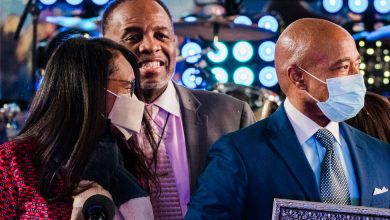‘Escalation of Secrecy’: Global Brands Seek Clarity on Xinjiang

In the summer of 2019, an executive at Patagonia got a phone call from a trusted auditor working in China. A planned trip to visit some cotton farms in the region of Xinjiang wasn’t going to happen. Soon other barriers were thrown up. Information from suppliers in the region ran dry.
“We saw this escalation of secrecy,” said Matt Dwyer, the Patagonia executive who oversees the privately held outdoor apparel maker’s supply chains. He spent a year trying to figure out what was going on as media reports detailed widespread repression and forced labor of Uyghur people in Xinjiang.
“When you peel the onion, it starts to reek pretty quick,” Mr. Dwyer said. By July 2020, Patagonia had decided to break the two-decades-long ties with its Chinese partners and build relationships with new cotton farmers, ginneries and spinners in other countries.
China’s repression of the Uyghur people is in the spotlight this week after hacked police documents detailed systemic abuse in Xinjiang. Michelle Bachelet, the United Nations high commissioner for human rights, is also visiting the region on a trip that faces severe limitations. Her movements have been confined to what Chinese officials describe as a “closed-loop bubble” to prevent the spread of the Covid-19 virus, dashing any hope of an assessment of the repression of the Uyghurs and prompting the United States to call it a mistake.
China’s leader, Xi Jinping, told Ms. Bachelet this week that his country didn’t need “patronizing lectures” about human rights issues, according to Chinese state media.
The lack of access in Xinjiang has also made it pretty much impossible for global clothing brands like Patagonia to figure out if their Chinese suppliers use forced labor.
At best, their auditing firms have been offered factory visits by video. At worst, local monitoring staff members are harassed and their offices raided and shut down by the Chinese police.

A survey last year found that 16 percent of cotton clothes being sold in the United States contained fiber from Xinjiang.Credit…Getty Images
Cotton from Xinjiang is widely used in the global garment industry. As of last fall, 16 percent of cotton clothes on store shelves in the United States had fiber from Xinjiang, according to a survey by Oritain, a company that does forensic testing to determine the origin of raw materials. But regulation soon to go into effect in the United States will allow customs officers to seize shipments of any goods that are made in Xinjiang unless companies can prove their supply chains are not tainted with forced labor.
The new rule, called the Uyghur Forced Labor Prevention Act, and the inability of companies to determine what is happening in their supply chains are unraveling decades of the clothing industry’s expansion in China.
Understand the Supply Chain Crisis
- The Origins of the Crisis: The pandemic created worldwide economic turmoil. We broke down how it happened.
- Explaining the Shortages: Why is this happening? When will it end? Here are some answers to your questions.
- A New Normal?: The chaos at ports, warehouses and retailers will probably persist through 2022, and perhaps even longer.
- A Key Factor in Inflation: In the U.S., inflation is hitting its highest level in decades. Supply chain issues play a big role.
“That era is drawing to a close because of the gravity of the forced-labor crisis and the broader human-rights crisis in the Uyghur region,” said Scott Nova, executive director of the Worker Rights Consortium, a steering committee member of the Coalition to End Forced Labour in the Uyghur Region. “The increasing authoritarianism of the Chinese government across the board is creating a situation where business as usual isn’t feasible anymore.”
Calculating whether to leave Xinjiang is complicated for international brands. The reputational risk and legal costs from the West that they could incur by staying are huge, yet brands face large commercial losses in China if they leave. There is also the challenge of finding new partners, when the costs of both cotton and shipping have soared and competition has increased.
Speaking out about Xinjiang can unleash fury from nationalistic Chinese consumers, like calls for boycotts and accusations of companies being complicit with Western governments in trying to keep China down. That anger has translated into lost sales totaling hundreds of millions of dollars for companies like H&M and Nike.
Brands are typically keen to showcase actions they have taken against forced labor, but when it comes to Xinjiang many simply avoid the subject altogether. Some fear that speaking out might imperil their other China operations and provoke officials to delay shipments of their goods. Mr. Nova at the Worker Rights Consortium said some brands had given him informal commitments to leave China but on the condition that the information remain private.
Prominent fashion brands like Reformation have spoken out in the past about labor issues but declined a request for comment for this article.
Patagonia’s willingness to share its experience in moving its cotton supply chain out of China stems in part from a corporate identity rooted in activism. And its executives have decided that their relatively small presence in China is worth risking.
“We were faced with a moral decision that was in direct conflict with a business decision,” Mr. Dwyer said. After unsuccessfully contacting its Chinese suppliers, farmers and spinners to try to get more information about reports in 2019 of forced labor in Xinjiang, Patagonia hired research firms to look into the accounting and financial documents of its partners. It was soon clear that getting details would be very difficult.
“When it came down to it, yes, we believe these things are happening,” Mr. Dwyer said. “We didn’t believe staying there for the sake of our revenue was worth it.”
Patagonia developed partnerships in Xinjiang two decades ago after deciding in the mid-1990s to use organic cotton. When it cut its ties with Chinese suppliers in 2020, Patagonia had to phase out some products that had been available for more than a decade because the fabric couldn’t be easily replicated.
Patagonia has now turned to cotton farmers in Peru, but many are still transitioning to growing organic cotton. As a result, Patagonia has had to change product labels to note they are made with “cotton-in-conversion.”
Around the time that Patagonia was asking questions about Chinese suppliers, Eileen Fisher, another privately held clothing brand, began to take a look at its own operations in China, which are mostly related to silk production. The company was one of dozens that pledged a decade ago to eliminate Uzbek cotton from their supply chains. That experience gave it “training wheels” to deal with Xinjiang, said Inka Apter, a designer for fabric research and development at Eileen Fisher.
Ms. Apter said that while no Eileen Fisher garments were being made in Xinjiang and that it wasn’t getting fabric or yarn from the region, the company didn’t know whether any of the cotton fiber it was using could be traced to Xinjiang.
“Two years of pandemic and a deteriorating political situation made it impossible to fully vet what is happening on the ground,” Ms. Apter said.
How the Supply Chain Crisis Unfolded
The pandemic sparked the problem. The highly intricate and interconnected global supply chain is in upheaval. Much of the crisis can be traced to the outbreak of Covid-19, which triggered an economic slowdown, mass layoffs and a halt to production. Here’s what happened next:
A reduction in shipping. With fewer goods being made and fewer people with paychecks to spend at the start of the pandemic, manufacturers and shipping companies assumed that demand would drop sharply. But that proved to be a mistake, as demand for some items would surge.
Demand for protective gear spiked. In early 2020, the entire planet suddenly needed surgical masks and gowns. Most of these goods were made in China. As Chinese factories ramped up production, cargo vessels began delivering gear around the globe.
Then, a shipping container shortage. Shipping containers piled up in many parts of the world after they were emptied. The result was a shortage of containers in the one country that needed them the most: China, where factories would begin pumping out goods in record volumes.
Demand for durable goods increased. The pandemic shifted Americans’ spending from eating out and attending events to office furniture, electronics and kitchen appliances – mostly purchased online. The spending was also encouraged by government stimulus programs.
Strained supply chains. Factory goods swiftly overwhelmed U.S. ports. Swelling orders further outstripped the availability of shipping containers, and the cost of shipping a container from Shanghai to Los Angeles skyrocketed tenfold.
Labor shortages. Businesses across the economy, meanwhile, struggled to hire workers, including the truck drivers needed to haul cargo to warehouses. Even as employers resorted to lifting wages, labor shortages persisted, worsening the scarcity of goods.
Component shortages. Shortages of one thing turned into shortages of others. A dearth of computer chips, for example, forced major automakers to slash production, while even delaying the manufacture of medical devices.
A lasting problem. Businesses and consumers reacted to shortages by ordering earlier and extra, especially ahead of the holidays, but that has placed more strain on the system. These issues are a key factor in rising inflation and are likely to last through 2022 — if not longer.
The company debated what to do.
“You know, maybe this farm got certified, but we have no way to independently audit, the people are intimidated, the auditors don’t want to work on the ground anymore, it’s impossible to really go by that,” Ms. Apter said, recalling the discussion.
By 2021, Eileen Fisher had removed any Xinjiang cotton fiber from its supply chain, she said.
L.L. Bean, the privately held outdoors retailer based in Maine, said in a statement that it had ceased sourcing from textile mills in Xinjiang in 2020 and “completely removed ourselves out of the cotton production process” in early 2021.
“We have full confidence in our due diligence process to state that none of our products are made with Chinese cotton or use forced labor,” the company said.
The decisions by smaller, privately owned companies to leave China have been more straightforward than they were for bigger retailers, which have cultivated a lucrative consumer market in the country. For fast fashion companies like H&M and luxury brands like Burberry, which has also been the target of boycotts, the decision ultimately amounts to picking a side: China or the rest of the world.
“It’s very hard for a giant company,” said Michael Posner, who is the chair of the Fair Labor Association, a nonprofit organization that has worked with companies like Apple to investigate worker conditions at suppliers’ factories.
“It’s possible to say, ‘We’re trying,’ and they are, but they are nowhere close to achieving a system where their cotton comes from other places,” he added.
Many bigger companies outsource the manufacturing of their products to companies like Li & Fung, a Hong Kong-based company that connects big-brand retailers with manufacturers in China.
Li & Fung did not respond to a request for comment, but its chief executive, Joseph Phi, recently gave an interview to Nikkei Asia, a Japanese media group. When asked whether Li & Fung worked with factories in Xinjiang, Mr. Phi did not respond.
Instead, he told Nikkei that the subject of Xinjiang had become politicized and that Li & Fung was apolitical. “We don’t take certain positions,” he said.



